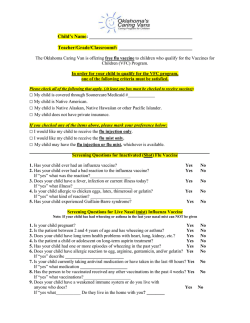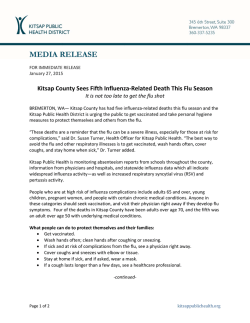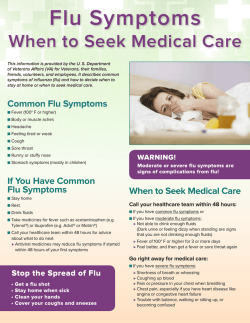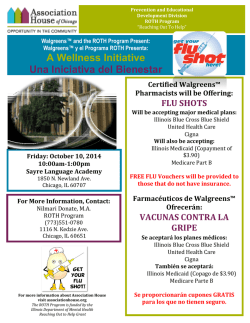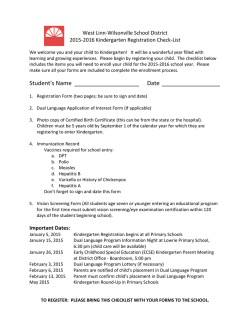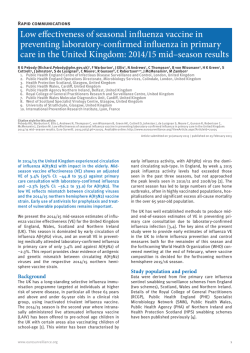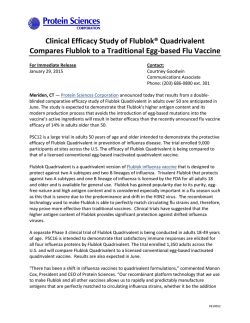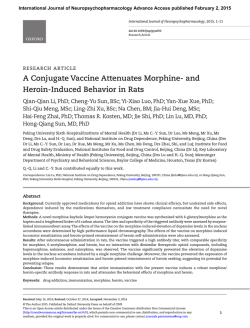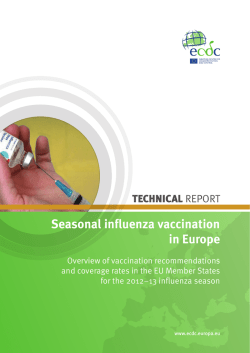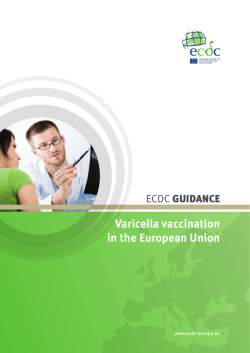
Flu Care in Day Care: The Impact of Vaccination Requirements
Flu Care in Day Care: The Impact of Vaccination Requirements A Report by the National Foundation for Infectious Diseases January 2015 January 2015 Flu Care in Day Care: The Impact of Vaccination Requirements Overview While we’re encouraged by the “ improvement in flu vaccination rates, there is more work to do to ensure all children are immunized every year. One area of focus has been implementing vaccination requirements in the day care and preschool setting. ” — Carol J. Baker, MD Despite the availability of safe and effective vaccines, tens of thousands of young children in the United States are hospitalized each year for influenza (flu). To protect as many young children as possible, New Jersey, Connecticut, and New York City have each implemented influenza vaccine requirements for children enrolled in licensed preschools, child care, or day care centers.* The National Foundation for Infectious Diseases (NFID), in collaboration with the Association of Immunization Managers (AIM), brought together key professionals from all three jurisdictions to discuss the challenges and key lessons learned in the planning and implementation of the regulations. These professionals were joined by immunization stakeholders, including members of the Childhood Influenza Immunization Coalition (CIIC). This report presents case studies from each jurisdiction along with an integrated set of lessons learned and key elements of successful programs (page 6) to help others considering implementing similar regulations. *The terms child care and day care have been used interchangeably. In this report, both of these terms refer to licensed settings for children younger than five years of age. 1 Figure 1: Children are a source of infection for the entire community10,11 Childhood influenza and the need to increase vaccination In the US, annual influenza vaccination is recommended for everyone six months of age and older.1 While vaccination is important for everyone, certain groups, including young children, are at higher risk of serious illness and even death from flu. Children age five years and younger commonly need medical care because of flu, and severe flu complications are most common in children age two years and younger.2 Other children Family members and other close contacts Children Flu seasons vary in severity, however, each year an average of 20,000 children younger than age five are hospitalized due to flu complications.2 In addition, there were more than 400 flu-related deaths in children over the last four years.3 Children under five years of age account for a disproportionate percentage of pediatric deaths. While 26 percent of all children in the US are under the age of five, this age group represented 39 percent of pediatric flu deaths reported from 2004 through 2012, and nearly half were previously healthy.4, 5 The best way to protect children against the flu is to get them vaccinated annually. Following the 2008 Centers for Disease Control and Prevention (CDC) recommendation for flu vaccination of all children age six months and older, flu vaccine coverage rates in children age six months through four years have reached 70 percent.6 While seven out of 10 young children are immunized, the 30 percent coverage gap represents millions of unvaccinated children nationwide. The gap is not uniform, though; in some states the rate of unvaccinated children younger than age five years is closer to 50 percent.6 day care, preschool, school Community including high-risk populations Courtesy of New York City Department of Health and Mental Hygiene effective. A study by researchers at the Yale School of Public Health found that since Connecticut’s regulations took effect in the 2010-2011 flu season, there has been an increase in flu vaccination rates and that higher vaccination rates are reducing flu-related hospitalizations in young children.8, 9 Flu vaccine coverage rates are among the lowest of any routinely recommended vaccine for children. This may be partly due to a perceived difference in the severity of flu compared with other infectious diseases7 as well as the need for annual vaccination, illustrating the importance of ongoing education and awareness programs. While previous flu vaccination increases the odds of getting vaccinated again, some parents may forget to seek the vaccine for their children without reminders from their healthcare professionals (HCPs) or public health officials. The focus on children in preschool and day care centers is understandable for several reasons. Children in these settings have an increased risk of exposure to flu viruses, which are spread very easily among young children.8, 9 There is also proof that widespread vaccination within these settings not only protects those who are vaccinated, but also reduces transmission of flu virus outside of these settings—to siblings, parents, grandparents, and ultimately to the community at large (see Figure 1).10, 11 Regulations help drive and maintain higher vaccination rates The idea of vaccine regulations is not new. Every state, as well as the District of Columbia, has vaccine requirements for school entry. There are also longstanding mandates for vaccines in healthcare workers, such as hepatitis B, varicella, measles, mumps, While it is difficult to assess the direct impact of preschool and day care flu vaccine requirements, there is early evidence that suggests such requirements can be 2 rubella, and pertussis.12 More recently, hospitals and health systems have implemented mandatory flu vaccine requirements. Facilities with these requirements have higher and more sustained vaccination rates than the national average (97.8 percent versus 75.2 percent).13 New Jersey Flu Vaccine Requirement “Children six months through 59 months of age attending any child care center or preschool facility on or after September 1, 2008, shall annually receive at least one dose of influenza vaccine between September 1 and December 31 of each year.” Vaccine requirements in the day care and preschool settings are an effective way to reach 100 percent coverage rates, and sustain high coverage levels in young children. A recent national poll shows that parents support day care policies that ensure children are up to date on vaccines.14 Three-quarters of parents want day care providers to check vaccination records annually and 41 percent support policies that remove unvaccinated children from day care. The decision was made to include only one flu vaccine dose in the requirement versus the two recommended by CDC for many children because the state recognized the challenges in delivery, monitoring, and recording of the second dose. The state relies on HCPs to recall and administer the second dose to all who need it. The following case studies were presented during a November 2014 webinar discussion. The presentations covered a range of topics including the process of establishing flu vaccination requirements in preschools and day care centers, as well as challenges and effective strategies. In 2012, New Jersey’s 88 percent vaccination coverage in children age four years and younger was 18 percentage points above the national average. As officials expected, the regulation was met with some pushback from anti-vaccine groups. The arguments made centered on common myths and misconceptions about flu, such as flu not being a serious disease, and flu vaccine safety, such as thimerosal concerns, which have been disproved by many scientific studies.15 Case Studies: Planning and Implementing Mandates New Jersey leads the way with preschool and day care flu vaccination requirements in 2008 It took two years from the original proposal to implementation in New Jersey, and the NJDOH pushed the operational date back one year to 2008 to allow all parties involved the necessary time to prepare to meet the new requirements. The first official notification was sent out in February 2008, one month after publication of the new requirements in the New Jersey Register. The notifications were sent to public health departments; schools and day care centers, with a request to share the information with parents; HCPs, who were advised to adjust their flu vaccine orders for future seasons; and various media outlets. Anticipating the first year as a transitional year, NJDOH also sent a reminder letter in June 2009. In the late 1990s, the New Jersey Department of Health (NJDOH) demonstrated its conviction about the importance of raising vaccination coverage levels for vulnerable populations when it mandated that all individuals 65 years and older residing in long-term care facilities or who were hospitalized be screened and offered influenza and pneumococcal vaccines. Once older adults were addressed, “the next logical step,” according to Jeni Sudhakaran of NJDOH, “was to focus on the child care and preschool cohort that is also at risk for flu complications.” Children in congregate school settings pass influenza very easily.8, 9 Non-compliance is actively enforced through the local public health departments, although NJDOH did allow waivers for the first few years of implementation. Annual audits measure both vaccination rates and compliance. Citations and fines are levied to child care centers and preschools that fail to exclude children who are not otherwise exempt for religious and medical reasons from influenza vaccination. Children may be excluded from school until they are vaccinated, or until March 31 when flu activity typically declines. NJDOH identified and addressed several challenges as it implemented the requirement. Because the seasonal flu vaccine supply may not be available before school begins, the regulation provides a four-month window for HCPs and the public to meet the vaccination requirement. The compliance date (December 31) also facilitates the state’s ability to monitor vaccine uptake because it coincides with New Jersey’s Annual Immunization Status Report. 3 Connecticut child care law: Vaccine recommendations are standard of care Public Health started to receive calls—an average of 10 to 15 per day for seven months, peaking in December and early January, coinciding with the vaccination deadline. According to Dr. Kathy Kudish, “The calls came from parents, child care providers, and a handful of physicians with questions about vaccine safety and efficacy, where to get available vaccine, and compliance issues.” The calls required staff time, and “a lot of patience for everyone involved.” Connecticut enacted flu vaccine requirements in child care centers and preschools two years after New Jersey. Discussions about a flu vaccination requirement in Connecticut began in 2008 and were first implemented during the 2011 flu season. In Connecticut, child care (but not preschool) vaccination requirements are tied by statute to current Advisory Committee on Immunization Practices (ACIP) recommendations, meaning that regulatory changes were not required to implement a new vaccine requirement, but enforcement was not necessarily immediate. Similar to New Jersey, Connecticut compiles annual vaccination data. Prior to implementation of the new vaccine requirement in 2010, reports from the state’s 1,200 child care providers were due in the fall. Therefore, the state had to collect flu data retrospectively for the first year, but has since moved the annual survey to January to allow for more timely collection of flu vaccine data. Connecticut, like New Jersey, requires and collects data on only one flu vaccine dose to facilitate compliance among HCPs to collect and report data. Connecticut: Influenza Vaccine Requirement in Child-Care Settings “By January 1, 2011 and each January 1 thereafter, children aged 6-59 months shall receive at least one dose of influenza vaccine between September 1 and Figure 2: Impact of requiring influenza vaccination for children in child care or preschool programs, Connecticut8 December 31 of the preceding year. All children aged 6-59 months who have not received vaccination against influenza previously shall receive 2 doses of vaccine the first influenza season they are Percent Vaccinated, Children age 6-59 months Influenza-Hospitalized, Incidence per 100,000 (age 0-4 years) vaccinated.” State officials consider several factors before enforcing any new vaccine requirement including vaccine supply; uptake rate (typically at least 50 percent); HCP acceptance of the recommendation; and adequate time following the ACIP recommendation to raise comfort levels about vaccine safety. 90 84.1% 80 70 67.8% 58.6% 60 Child care providers and HCPs were notified of the new requirement in May 2010, three to four months before the start of flu season, and seven months before the January 1, 2011 deadline. Information, including a Q&A modeled after one developed in New Jersey, was posted online with open access.16,17 The Connecticut Department of Public Health also held workshops in the summer with several larger child care providers in the state. 51.5% 10 Child care providers were responsible for notifying parents of the new flu vaccine requirement for child care attendance and collecting immunization information from enrollees. As parents learned about the new flu vaccine requirement, the Connecticut Department of 0 2008-2009 2012-2013 Influenza Season 4 HOSPITALIZED 20 VACCINATED 30 HOSPITALIZED 40 VACCINATED 50 Since 2010 when the regulations took effect, Connecticut has seen flu vaccine coverage rates increase in children age 4 years and younger while its rate of flu-related hospitalizations went from the third highest to the lowest among all of the CDC Emerging Infections Program sites. One case of flu in a child younger than age five years is associated with out-of-pocket costs of $52 to $178 and lost wages for the parent of $222 to $1,456 (expressed in 2009 US dollars).18 For every 100 children with influenza, the city estimates 195 lost work days for parents. Unlike child care centers, influenza vaccine regulations for preschools require regulatory changes in Connecticut, which resulted in a one-year implementation delay in preschools. Officials noted that there was little opposition at public hearings about the preschool law, which they speculate might have been because the hearings followed close on the heels of the 2009 H1N1 pandemic and public perception of the severity of flu was high. In a city of more than eight million people, only 19 commented at the public hearings held to discuss the proposed flu vaccine requirement. Another 276 submitted written comments. Those who spoke in person, and most of those who submitted comments in writing, appeared to be mobilized by anti-vaccine groups. Nearly half of the letters submitted were an identical form letter and 25 percent of those who commented were not city residents. Those who spoke in support of protecting children included physicians, the American Academy of Pediatrics, the New York City Coalition for Childhood Immunization Initiatives, nurse advocacy groups, health clinics, hospitals, and one school. Based on the earlier experience with timing issues for collection of flu data, Connecticut opted to collect preschool flu data separately from other vaccines. The flu survey is mailed in January, while the survey for all other vaccines continues to be mailed in the fall. School nurses collect the data prospectively and are advised to exclude unimmunized children from the preschools unless they are exempted. Like New Jersey, children are excluded from school until March 31 or until they receive at least one dose of influenza vaccine. Communicating the new requirements to the city’s eight million residents would be a challenge. “We knew we had to prepare a comprehensive educational plan to be sure everyone affected by the new mandate was aware of it and had ample time to meet the regulations,” said Renée Noël, of the New York City Department of Health and Mental Hygiene (NYC DOHMH). The Board of Health sent notices to pediatric healthcare providers following approval of the mandate. The city also created posters and health bulletins, and sent immunization requirement letters to child care directors and parents. The Department of Health and Mental Hygiene also made in-person presentations to community-based organizations and the Administration of Children’s Services. Finally, New York City also implemented a multi-lingual media campaign that included TV commercials and subway advertisements. New York City makes flu vaccination in day care population a “top priority” New York City’s flu vaccine regulation was a collaborative effort between two segments of the city’s health department—the Bureau of Immunization (BOI) and the Bureau of Child Care (BCC). The latter oversees all of New York City’s child care centers. New York City Influenza Vaccine Regulation “All children 6 months to 59 months enrolled in child care must receive one dose of the influenza vaccine by December 31 of each year.” Since New York City’s regulation has only been in effect since January 2014, results are not yet available, though the city’s goal is a coverage rate of 90 percent or higher. As with the flu vaccination regulations in New Jersey and Connecticut, the New York City mandate will be enforced by education only in the first year. Violation notices that carry financial penalties will begin in January 2016. The NYC DOHMH strongly encourages exclusion of unvaccinated children but leaves it up to the discretion of the child care center. New York City made influenza vaccination for children who attend day care centers a priority based on the increased likelihood that this population will contract flu and suffer complications. In addition to morbidity and mortality in these young children, and their role in transmitting the virus to their families and the larger community (reasons also cited by New Jersey and Connecticut in enacting their regulations), New York City also recognized the financial impact of flu on families. 5 Learning by Example: Lessons from New Jersey, Connecticut, and New York City Key Elements in Implementing Flu Vaccination Requirements Many of the following key elements in planning for and implementing flu vaccination requirements in preschools and day care centers can also help raise vaccination rates in the absence of specific regulations. New Jersey, Connecticut, and New York City officials learned valuable lessons while planning and implementing flu vaccination requirements. P repare and implement a comprehensive It is challenging for HCPs and parents to get every communications plan. Communicate early and often with parents, day care providers, media, HCPs, and others—beginning well before requirements are implemented. Even vaccine supporters will need ample time to plan and prepare to meet new requirements. Work closely with all stakeholders to ensure consistent messaging. child vaccinated against flu on an annual basis. It will take some time for all involved to ramp up their efforts and make annual vaccination routine. All those involved in delivering messages to parents will need tools to help provide clear and consistent messages. Connecticut officials determined that even though funds were limited, they would have done better if they had provided posters or flyers to child care providers, even if they were only available online. Address educational/awareness barriers by providing ongoing education to parents, HCPs, community leaders, school administrators, teachers, and policymakers about the impact of flu in young children and the safety and efficacy of flu vaccines. Anticipate the need to inform and educate parents whose children are new to the preschool or day care center. E ven with a four- to five-month lead time, compliance by December 31 can be a challenge. To assist, New Jersey set up flu vaccine clinics throughout the state, but noted that parents who wait too long may have a hard time accessing the vaccine as the deadline approaches, due to diminished supply. L ocate and assess available tools that can help New flu vaccine requirements spurred an increase overcome barriers related to attitude, awareness, motivation, and access to flu vaccine. Visit www.nfid.org/day-care for links to valuable resources about increasing vaccination rates in day care and preschool settings. in religious exemptions in both New Jersey and Connecticut. New Jersey also broadened its religious exemption rule, which may also have had an impact on the increase in exemption rates in the state. The timing for flu vaccination tracking may not Recognize the unique challenges of flu vaccine coincide with existing tracking for other childhood vaccines. Tracking due dates may need to shift to allow time to capture flu vaccine data. This may, in turn, slow a jurisdiction’s ability to compile results for all vaccines and to begin validation audits by local public health departments. timing. Flu vaccine supply and timing is not as precise as it is for other vaccines. The vaccination “due by” date is the end of the year and only one dose is required and tracked. Consider opportunities to provide day care centers, preschools, and the healthcare system with ample time to prepare and meet requirements. State regulatory processes may not keep pace with CDC recommendations. Current requirements in all jurisdictions are for children through age 59 months based on older CDC recommendations. But newer recommendations go beyond this age (to age 18 years) and there are children older than 59 months who attend preschool and day care programs. E valuate and consider expanded infrastructure for flu vaccine delivery. In addition to private HCP offices, pharmacies, public health departments, and hospital- or school-based clinics may all be viable options for administration of flu vaccine to young children. 6 Learn from unintended consequences experienced by others. New Jersey and Connecticut saw increases in religious exemptions, specifically for flu vaccine, following the establishment of regulations. New Jersey also noted an expansion of exemptions for other vaccines. Increased efforts to ensure parents understand the risks of flu and the safety of the vaccine may help reduce the number of vaccine exemptions. About the Childhood Influenza Immunization Coalition (CIIC) Created in 2007, CIIC is a coalition of more than 30 leading medical, public health, and parent organizations brought together by NFID to help address and improve influenza immunization rates among children. For more information and a list of current members, visit www.preventchildhoodinfluenza.org. A ddress the challenges in flu vaccination rate tracking. Officials in both Connecticut and New Jersey made changes to timing of reporting for vaccines to streamline data collection. E nsure compliance with an enforcement Panel mechanism. All of the jurisdictions have a reporting system in place to monitor compliance. Noncompliance will result in citations, fines, and/or exclusions. Allow some time to enforce compliance through education before activating full penalties. Moderator: Carol J. Baker, MD, NFID past-president, Childhood Influenza Immunization Coalition (CIIC) chair, and professor of Pediatrics, Molecular Virology & Microbiology at Baylor College of Medicine C ollaborate with all stakeholders. Officials stressed the importance of working closely with all stakeholders in all phases from planning to implementation to evaluation. Speakers: Kathy Kudish, DVM, MSPH, Supervising Epidemiologist, Immunization Program, Vaccine-Preventable Disease Unit, Connecticut Department of Health For more information and resources on influenza prevention in day care and preschools, visit: www.nfid.org/day-care. Renée Noël, MPH, Assistant Director for Field Operations, Bureau of Child Care, New York City Department of Health and Mental Hygiene Jeni B. Sudhakaran, MPH, Population Assessment Coordinator, Immunization Program, New Jersey Department of Health 7 References 1. 2. 3. Grohskopf LA, Olsen SJ, Sokolow LZ, et al; Centers for Disease Control and Prevention. Prevention and control of seasonal influenza with vaccines: recommendations of the Advisory Committee on Immunization Practices (ACIP) – United States, 2014-15 influenza season. MMWR Morb Mortal Wkly Rep. 2014;63(32):691-7. Centers for Disease Control and Prevention. Children, the flu, and the flu vaccine. cdc.gov/flu/protect/children.htm. Accessed November 20, 2014. Centers for Disease Control and Prevention. FluView: Influenza-Associated Pediatric Mortality, 2010-2014. gis.cdc.gov/GRASP/Fluview/PedFluDeath.html. Accessed December 10, 2014. 4. US Department of Commerce. United States Census, 2010. census.gov/prod/cen2010/briefs/c2010br-03.pdf. Accessed November 25, 2014. 5. Wong KK, Jain S, Blanton L, et al. Influenza-associated pediatric deaths in the United States, 2004-2013. Pediatrics. 2013;132:796-804. 6. Centers for Disease Control and Prevention. Flu vaccination coverage, United States, 2013-14 Influenza Season. cdc.gov/flu/fluvaxview/coverage-1314estimates.htm#data. Accessed November 20, 2014. 7. Baker CJ. Childhood influenza vaccination: understanding parent resistance and motivating behavioral change. An NFID Consumer Research Study. Presented at the National Immunization Conference, April 21, 2010. preventchildhoodinfluenza.org/newsroom/research/nationalimmunization-conference-2010-presentation.pdf. Accessed December 2, 2014. 8. Hadler JL, Yousey-Hindes K, Kudish K, Kennedy ED, Sacco V, Cartter ML. Impact of requiring influenza vaccination for children in licensed child care or preschool programs— Connecticut, 2012-13 influenza season. MMWR Morb Mortal Wkly Rep. 2014;63(9):181-5. 12. Centers for Disease Control and Prevention. Immunization of health-care personnel: recommendations of the Advisory Committee on Immunization Practices (ACIP). MMWR Recomm Rep. 2011;60(RR-7):1-45. 13. Centers for Disease Control and Prevention. Influenza vaccination information for health care workers. cdc.gov/flu/healthcareworkers.htm. Accessed November 25, 2014. 14. CS Mott Children’s Hospital. National poll on children’s health: Parents support daycare policies to get kids up-to-date on vaccines. mottnpch.org/sites/default/files/documents/111714_ daycarevaccines_0.pdf. Accessed November 25, 2014. 15. Centers for Disease Control and Prevention. Thimerosal and 2014-2015 Seasonal Flu Vaccines. cdc.gov/flu/protect/vaccine/thimerosal.htm. Accessed December 11, 2014. 16. Connecticut Department of Public Health. School Flu Immunization Requirement: Q+A. ct.gov/dph/lib/dph/infectious_diseases/immunization/q__a_ flu_vaccine_requirement_for_schools.pdf. Accessed December 13, 2014. 17. New Jersey Department of Public Health. Questions and Answers on Immunization Regulations Pertaining to Children Attending School/Higher Education. nj.gov/health/cd/documents/vaccine_qa.pdf. Accessed December 13, 2014. 18. Ortega-Sanchez IR, Molinari NA, Fairbrother G, et al. Indirect, out-of-pocket and medical costs from influenza-related illness in young children. Vaccine. 2012;30(28):4175-81. 9. Centers for Disease Control and Prevention. Infectious diseases at school. cdc.gov/healthyyouth/infectious/. Accessed December 2, 2014. 10. Hurwitz ES, Haber M, Chang A, et al. Effectiveness of influenza vaccination of day care children in reducing influenza-related morbidity among household contacts. JAMA. 2000;284:167782. 11. Reichert TA, Sugaya N, Fedson DS, Glezen WP, Simonsen L, Tashiro M. The Japanese experience with vaccinating schoolchildren against influenza. N Engl J Med. 2001;344:88996. 8 Copyright © 2014 National Foundation for Infectious Diseases. Copyright © 2015 National Foundation for Infectious Diseases. www.nfid.org
© Copyright 2024
